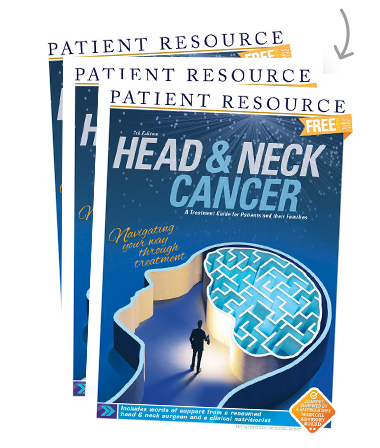Head & Neck Cancer
Survivorship
Recovery from the physical, emotional and mental aspects of head and neck cancer can take more time than you may expect. Be patient as you adjust to this next phase of your life. Moving into survivorship may bring challenges, but it can also offer new opportunities. Be prepared to explain to family, friends, employers and coworkers that you have had a life-altering experience and that some things may have changed.
Set realistic expectations about resuming the routine you had before you were diagnosed with cancer. What was important to you before your cancer diagnosis may no longer be a priority. You may rethink your career path, or you may need modifications at your current job that will allow you to continue being productive. Your employer is required under the Americans with Disabilities Act (ADA) to provide reasonable accommodations. Meet with your human resources representative for details about the ADA and how it applies in your workplace.
You may be surprised to find you feel lonely. Until now, you have been surrounded by many people who continually monitored your care. That support was comforting. Though you won’t have as much contact with your medical team, it is important that you continue to have support. Some larger cancer centers and community treatment centers provide survivorship clinics and programs for adults who have had cancer treatment, or you can search online for one. Consider joining a cancer support group or joining the survivor community in another way. There is still more to learn, and sharing your knowledge could offer hope to other survivors.
Your Survivorship Plan
Managing your health is easier when you have a plan. Once therapy is finished or as you continue with maintenance therapy, you will work closely with your doctor to develop a survivorship plan.
Following are the common parts of a plan. Yours will be customized for you based on your diagnosis and treatment history, age and other health conditions, and your expectations for the future.
Medical history. This information may include your diagnosis, immunizations, past and current medications, and past and ongoing health conditions. It may also include your family medical history.
Your diagnosis should include the cancer type, subtype and tumor site(s); stage or classification; date of diagnosis; diagnostic test results and pathology reports; and, if applicable, tumor grade, molecular biomarkers present, genetic test results, hormonal status and a summary of second/third opinions.
Part of your medical history will also include a treatment summary that details the following:
- Hospital stays: Reasons, medications, recovery time and complications
- Surgeries: Type, inpatient or outpatient, recovery times and complications
- Radiation therapy: Type, site(s) and total amount of radiation
- Drug therapies: Type, drug names, dosages, duration, side effects and responses
- Supportive care (palliative care): Symptom management, medications (such as for anxiety or nausea), pain management, counseling or other support services for you and/or your loved ones
- Additional services: Physical or occupational therapy, fertility preservation, nutritional counseling, etc.
Follow-up care plan. Before you resume care with your primary care physician, ask your oncologist to set up a long-term follow-up care plan that includes set appointments for regular monitoring. It should also include the following information:
- Follow-up appointment schedule for ongoing monitoring.
- Maintenance medications or therapies, including type, dosage, frequency and duration.
- Referral(s) for cancer rehabilitation, such as physical or occupational therapy, speech therapy, a lymphedema specialist or others.
- Information about your risk of a recurrence, long-term treatment-related side effects and late effects, and a second cancer. Being diagnosed with a head and neck cancer increases your risk for second cancers as well as a recurrence. The risk varies depending on the site of the primary cancer and alcohol and tobacco-related product usage, such as cigarettes, chewing tobacco and electronic cigarettes; the presence of the human papillomavirus (HPV); poor dental hygiene; and prolonged exposure to the sun, which is linked to cancer of the lip.
- Note the health care team members you will see for follow-up care, and include their contact information.
Health, wellness and lifestyle recommendations. These may include good nutrition habits, getting to or maintaining a healthy weight, improving fitness and increasing strength. You may have eating challenges from the cancer or its treatment. Working with a dietitian can help ensure you are able to get the nutrients your body needs.
Lifestyle changes such as stopping smoking and managing stress are important to discuss. Ask your primary doctor about getting vaccinations, such as those for COVID-19, shingles or influenza.
Life goals. You may have already shared these goals with your medical team when planning treatment. Now is also a good time to change them or add new ones that better fit in with where you are now.
Survivorship support and community resources. The resources should include your cancer center; survivorship clinics, support groups, cancer advocacy organizations and other local or area resources; survivor phone buddies and peer-to-peer matching; and online survivorship support groups and communities.
Your Survivorship Care Plan
Ask your doctor for a plan, or get started on your own. Download a sample Survivorship Care Plan at PatientResource.com/SurvivorshipPlan. Then, request copies of all your test and biopsy results, surgeries, pathology reports and consultation notes from your doctor’s office to fill it in.



